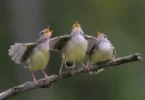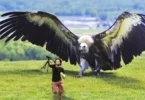Birds have captivated human interest for centuries with their beauty, grace, and diversity. Yet, among the avian world, there exists a subset that commands a different kind of attention – dangerous birds. These winged creatures, with their formidable beaks, talons, or venomous capabilities, evoke a mixture of fear and fascination.
From towering raptors to stealthy predators, each species brings its own unique blend of danger. Exploring the allure of these avian adversaries sheds light on our primal instinct to understand and respect the natural world’s most formidable inhabitants.
Let’s delve into the realm of the most dangerous birds on the planet.
Overview of the Most Dangerous Bird in the World:
In the vast tapestry of the avian kingdom, one species stands out as the epitome of danger – the cassowary. Native to the dense rainforests of Papua New Guinea, Australia, and nearby islands, the cassowary is renowned for its imposing stature, razor-sharp talons, and unyielding demeanor. Standing up to six feet tall and weighing over 100 pounds, these flightless giants command respect and caution from all who encounter them.
But what makes the cassowary the “most dangerous bird” in the world? It’s not just their impressive size, but also their remarkable agility, powerful legs, and the dagger-like claws capable of inflicting fatal wounds. While their primary diet consists of fruits and small animals, cassowaries have been known to display aggressive behavior when threatened or provoked, leading to serious injuries or even fatalities in rare cases.
Beyond their natural history, cassowaries hold a significant place in human encounters, often gaining notoriety for their confrontations with humans in their native habitats. Tales of territorial disputes, daring escapes, and harrowing encounters have solidified the cassowary’s reputation as a creature not to be trifled with.
Understanding the intricacies of the cassowary’s behavior and biology not only offers insight into the complexities of the natural world but also serves as a reminder of the importance of respecting and coexisting with Earth’s most formidable inhabitants.
Physical Characteristics:
The cassowary’s menacing reputation stems from a formidable combination of physical traits that make it a force to be reckoned with in the animal kingdom. First and foremost is its imposing size, with adults reaching heights of up to six feet and weighing over 100 pounds. This sheer bulk, coupled with powerful legs, enables the cassowary to deliver bone-crushing kicks with devastating force.
However, it’s not just their size that makes cassowaries dangerous. They possess long, dagger-like claws on their inner toes, measuring up to five inches in length. These razor-sharp talons can inflict deep wounds capable of causing serious harm or even death to potential threats. Additionally, their strong, sturdy beaks, while primarily used for feeding, can also deliver powerful strikes when defending their territory or offspring. Together, these physical characteristics form the arsenal of weaponry that has earned the cassowary its rightful place as the most dangerous bird in the world.
Behavioral Patterns:
The cassowary’s danger lies not only in its physical prowess but also in its complex behavioral patterns. One of the most notable behaviors is its innate aggression, particularly when defending its territory or offspring. Cassowaries are fiercely territorial birds, often patrolling large areas of dense rainforest and vigorously defending their turf against intruders.
Furthermore, their territoriality is accompanied by a keen sense of awareness and a readiness to engage in confrontations with perceived threats. When provoked or cornered, cassowaries can exhibit aggressive displays, including hissing, lunging, and delivering powerful kicks with their legs.
In addition to territorial behavior, cassowaries employ stealthy hunting strategies to secure their prey, which primarily consists of small animals and fruits. With their cryptic plumage and silent movements through the undergrowth, they can catch unsuspecting prey off guard, striking with lightning-fast precision.
Understanding these behavioral patterns is crucial for navigating encounters with cassowaries and respecting their space in their natural habitat. Failure to do so can result in potentially dangerous interactions with these formidable birds.
Ecological Context:
A bird’s dangerousness is intricately tied to its ecological context and evolutionary history. In the case of the cassowary, its habitat in dense rainforests of Australasia has shaped its formidable traits. Over millennia, natural selection favored individuals with traits conducive to survival in these challenging environments, leading to the evolution of the cassowary’s size, strength, and weaponry.
Furthermore, the ecological role of cassowaries as apex predators and seed dispersers underscores their importance in maintaining the balance of their ecosystems. Understanding the interplay between ecological factors and evolutionary processes sheds light on why certain birds, like the cassowary, have earned their reputation as the most dangerous in the world.
Cassowary:
The cassowary, with its imposing stature, striking plumage, and lethal weaponry, commands respect as one of the most dangerous birds on the planet. Native to the dense rainforests of Australasia, this flightless giant stands up to six feet tall and weighs over 100 pounds. Armed with dagger-like claws and a powerful beak, the cassowary has earned a fearsome reputation for its aggressive territorial behavior and swift, deadly attacks when threatened. Tales of encounters with humans underscore the importance of understanding and respecting the cassowary’s space in its natural habitat, solidifying its status as a formidable avian adversary.
Ostrich:
The ostrich, Earth’s largest living bird, commands attention with its towering height and impressive build. Adult males can reach heights of up to nine feet and weigh over 300 pounds, making them formidable figures on the African savanna. Renowned for their remarkable speed, ostriches can sprint at speeds of up to 45 miles per hour, outpacing many predators. Despite their flightless nature, ostriches possess formidable defensive capabilities, including powerful legs armed with sharp claws capable of delivering devastating kicks to fend off threats. These remarkable adaptations have cemented the ostrich’s status as a force to be reckoned with in the animal kingdom.
Southern Cassowary:
The southern cassowary, a subspecies of the cassowary native to New Guinea and northeastern Australia, possesses a unique set of traits that contribute to its dangerous reputation. Similar to its cousins, the southern cassowary is known for its imposing size, standing up to six feet tall and weighing over 100 pounds. What sets it apart are its striking blue and black plumage and a brightly colored casque atop its head.
However, it is the southern cassowary’s razor-sharp, dagger-like claws that truly make it a formidable adversary. These formidable weapons, combined with its powerful legs and territorial nature, make the southern cassowary a force to be reckoned with in its native habitat.
Southern Cassowary:
The southern cassowary, a distinguished subspecies of its formidable cousins, possesses a unique blend of traits that solidify its dangerous reputation. Residing in the lush rainforests of New Guinea and northeastern Australia, this avian behemoth stands tall at six feet and boasts a weight exceeding 100 pounds.
What sets the southern cassowary apart is its vivid blue and black plumage, accented by a strikingly colored casque atop its head, adding to its mystique.
However, it’s the southern cassowary’s arsenal of weaponry that truly earns it respect in its habitat. Equipped with razor-sharp, dagger-like claws and powerful legs, this bird is a formidable adversary. Coupled with its territorial instincts, the southern cassowary commands both awe and caution, embodying the essence of a true avian powerhouse in its native domain.
Swan:
While often celebrated for their elegance and grace, swans harbor a surprising side to their temperament, particularly during nesting season.
Despite their serene appearance, swans can display remarkable aggression when it comes to defending their nests and offspring.
During nesting season, these typically placid birds become fiercely territorial, readily engaging in confrontations with perceived threats.
With powerful wings and strong beaks, swans are capable of delivering forceful blows to deter intruders. Their protective instincts extend beyond mere displays, with documented cases of swans chasing away larger animals, including dogs and humans, from their nesting sites.
This unexpected aggression serves as a reminder of the importance of respecting wildlife boundaries, even in seemingly tranquil settings.
Related Article : https://tdilaw.com/blog/eagle-eye-the-majesty-and-mystery-of-natures-icon/
Great Horned Owl:
The great horned owl, a nocturnal apex predator, reigns supreme in the darkness of the night. With keen senses and silent flight, this formidable bird of prey possesses unparalleled predatory prowess. Equipped with powerful talons and a razor-sharp beak, the great horned owl strikes fear into the hearts of its prey.
Under the cover of darkness, it prowls the skies, hunting a wide array of prey, including rodents, rabbits, and even other birds. Its exceptional vision and acute hearing enable it to locate and capture prey with remarkable precision, making it one of the most efficient hunters in the avian world.
In the realm of the night, the great horned owl reigns supreme as a silent, lethal predator.
European Herring Gull:
The European herring gull, commonly found in coastal regions and increasingly in urban areas, is known for its aggressive behavior, especially during the breeding season.
In densely populated areas, these opportunistic birds have adapted to urban environments, where they scavenge for food scraps and establish territories.
However, their territorial instincts can escalate into aggressive behavior, particularly when they perceive humans as threats to their nests or offspring.
Instances of herring gulls swooping down and attacking humans, especially during nesting season, have been documented in urban settings, prompting concerns about human-wildlife conflicts and the need for effective management strategies to mitigate such encounters.
Barred Owl:
With its haunting call echoing through the forest, the barred owl lurks as a silent predator of the night. This stealthy hunter, known for its striking barred plumage and piercing yellow eyes, possesses a voracious appetite for small mammals, birds, and even reptiles.
Utilizing its keen senses and silent flight, the barred owl swoops down upon unsuspecting prey with deadly precision. Its sharp talons and powerful beak make quick work of capturing and dispatching its quarry.
While typically shy and elusive, barred owls can become aggressive if threatened or cornered, posing a potential danger to those who intrude upon their territory or disturb their hunting grounds.
Australian Magpie:
The Australian magpie, known for its melodious song and striking black and white plumage, exhibits notable territorial behavior, particularly during breeding season.
As spring arrives, these intelligent birds become fiercely protective of their nesting sites, often marked by aggressive displays towards intruders.
During breeding season, Australian magpies are notorious for swooping attacks on unsuspecting passersby, particularly cyclists and pedestrians.
With remarkable precision, they dive-bomb intruders, aiming for the head and eyes with their sharp beaks and talons.
While these attacks are primarily defensive, they can cause injury and instill fear in those who unwittingly encroach upon the magpies’ territories, highlighting the importance of understanding and respecting wildlife boundaries.
African Crowned Eagle:
The African crowned eagle, a majestic raptor native to sub-Saharan Africa, commands attention with its impressive size and fearsome hunting prowess. Sporting a wingspan of up to six feet and adorned with a distinctive crest, this apex predator reigns supreme in the African skies.
However, it’s the African crowned eagle’s powerful talons that truly set it apart as a formidable hunter. Capable of exerting immense pressure, these razor-sharp claws are adept at seizing and dispatching prey, which can include monkeys, small antelopes, and other birds.
With unparalleled strength and precision, the African crowned eagle embodies the apex of avian predation, a true monarch of the African wilderness.
Red-tailed Hawk:
The red-tailed hawk, a widespread and iconic raptor of North America, boasts impressive hunting abilities that make it both admired and feared.
With keen eyesight and soaring flight, this formidable predator scans its surroundings for potential prey, which can range from small mammals to birds and reptiles.
Equipped with powerful talons and a sharp, hooked beak, the red-tailed hawk strikes swiftly and decisively, often delivering fatal blows to its victims. While typically shy and non-aggressive towards humans, red-tailed hawks can pose a potential danger when defending their nests or territories, particularly during breeding season.
Their combination of hunting prowess and territorial behavior underscores their status as top predators in their native habitats.
What Makes a Bird Dangerous?
Several factors contribute to a bird’s perceived danger level. Physical traits such as size, strength, and weaponry, including sharp talons and beaks, play a significant role.
Additionally, aggressive behavior, territoriality, and hunting strategies can increase the risk posed by certain bird species.
Environmental context, including habitat and evolutionary history, also influences a bird’s dangerousness.
Understanding these factors helps elucidate why certain birds, such as cassowaries and raptors, are regarded as formidable adversaries in the animal kingdom, and underscores the importance of respecting wildlife and their habitats to avoid potential conflicts.
Encountering Dangerous Birds:
Humans may encounter dangerous birds in various scenarios, including hiking or camping in their natural habitats, visiting wildlife sanctuaries, or living in urban areas where certain species have adapted to human presence.
In these situations, it’s crucial to remain aware of surroundings and respect wildlife boundaries. Avoiding sudden movements, especially near nesting sites or territories, can help minimize the risk of provoking aggressive behavior.
Additionally, wearing protective gear such as hats or helmets can mitigate injuries during swooping attacks by birds like magpies.
Understanding and respecting the behavior of dangerous birds is key to ensuring safe interactions in their environments.
Domesticating Dangerous Birds:
While some birds, such as parrots and falcons, have been successfully domesticated for centuries, the same cannot be said for inherently dangerous species like cassowaries or raptors. Domesticating these birds poses significant challenges and risks due to their wild instincts, aggressive behavior, and specialized dietary and environmental needs.
Attempting to domesticate dangerous birds can result in serious injuries or even fatalities, both for humans and the birds themselves. Furthermore, it may lead to ethical concerns regarding animal welfare and conservation efforts. As such, it is generally not recommended to attempt to domesticate inherently dangerous bird species, and they are best appreciated from a respectful distance in their natural habitats.







Leave a Comment